The 1994 USMNT World Cup team is dear to the hearts of many U.S. Soccer fans and fans in general of the sport. The team was a cast of characters that became instantly famous overnight, with their never say die attitude and their colorful looks.
Alexi Lalas sported a rock grunge look of the times, Tony Meola had his trademark ponytail, and Cobi Jones was 1990’s reggae fad embodied in a soccer player. The team was dressed in denim with stars and red shorts, a look that horrified the squad as they were drawn into Group A with Colombia, Romania, and Switzerland.
With the 94 World Cup being played on American soil a good performance by the team was very important given the animosity the sport had in the United States and the animosity the team had among their peers. Here is a look back at the 1994 World Cup that was for the USMNT.
Where the USMNT was at, at that moment
Four years removed from Italy 90, where the USMNT went 0-3 in their group and fielded college players to play among the best soccer players in the world, the program was no closer to being professional. While a few American players got professional contracts to play abroad it was still hard to get 11 players playing consistently in Europe.
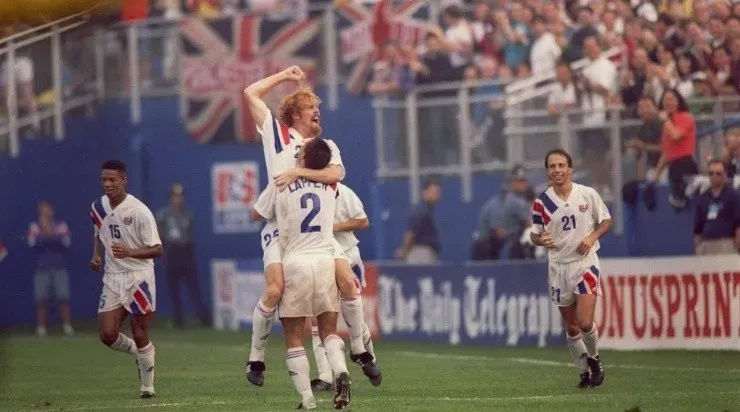
ALEXI LALAS OF THE USA CELEBRATES HIS GOAL AGAINST ENGLAND DURING THE 1993 US CUP MATCH. Mandatory Credit: Shaun Botterill/ALLSPORT
Many of the 1990 alumni had brief stints on teams across the world, Tony Meola had played for Watford in England but would nix a move to France to sign a long-term contract with the US Soccer federation with the sole purpose to prepare for the World Cup. Other players like Kasey Keller, Tab Ramos, and John Harkes had signed professional deals and had established respectable careers for themselves in England and Spain.
No American player at that time played for a top team, most were in the second division or fighting for bottom feeders to avoid relegation in the top flights. Still, US Soccer had a plan, and that plan was to get the USMNT ready for the only games that mattered, the 3 first round games in 1994.
US Soccer’s plan for the 1994 World Cup
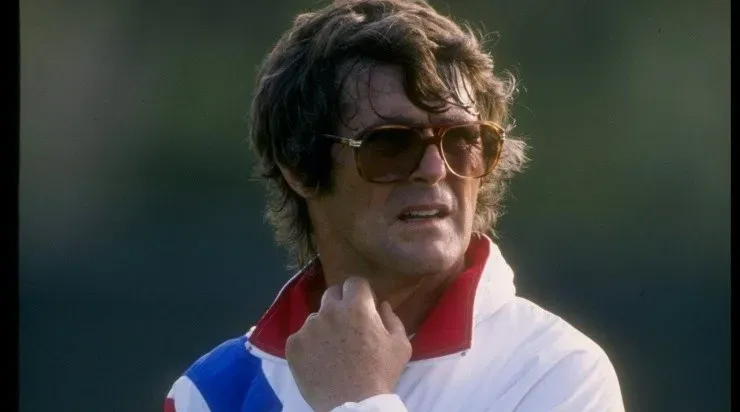
Bora Milutinovic (Getty Images)
In 1991 US Soccer hired Serbian Bora Milutinovic to lead the team towards the 1994 tournament. “Bora” as he is known the world over was very familiar with the US team and Concacaf having coached Mexico in the 1986 World Cup and Costa Rica in the 1990 tournament. In each case he took the underachieving nations into the second round of both World Cups.
Bora was known in the soccer world as a magician, often molding his inexperienced sides into defensive and organized teams that could pull off a result or two. With the US, Bora had a lot of what he lacked in Mexico and Costa Rica, better resources, kind of, and a free will to do whatever he wanted. He also had a huge problem, a handful of players were actually playing top level soccer the rest were in a sort of soccer limbo, club less or playing in makeshift “professional” soccer leagues in the United States.
Milutinovic didn’t let the lack of a league slow him down and he scouted and searched the entire country for soccer players, mostly in the college system. Bora played any player he thought could be a good addition to the team. From 1991 until before the World Cup, Bora made sure the US team played everyone and anyone.
The USMNT participated and won the 1991 Concacaf Gold Cup, which gave the program a much needed shot in the arm in terms of legitimacy, even though not many took notice. Only 4 players on the squad were playing professionally in Europe, with Paul Caligiuri playing for Hansa Rostock.

Eric Wynalda and coach Bora Milutinovic discuss tactics on board the airplane on their way to a match in the 1994 Soccer World Cup. (Getty Images)
The federation would eventually set up a sort of camp in Mission Viejo, California and the USMNT set off to play any team they could. In an interview with the BBC, Milutinovic stated, “The players needed to feel what it meant to play at the highest level… We toured around the world – playing Sweden, Russia, North and South Korea, Brazil, Argentina, Uruguay, Paraguay. There was a great spirit, and the players were mentally very strong. It was important to play so many games against different countries to learn what we needed to do and how we needed to do it. You can learn a lot more from playing against teams like this than teaching the players for many hours. In training we’d learn the mental side of the game, playing with and without the ball, then it was all friendlies and traveling. It was simple but it had amazing results.”
Along the way the USMNT would play the 1992 Confederations cup, posting third defeating the Ivory Coast, in 1993 they played the Copa America in Ecuador, having a respectable showing losing 2 games and drawing 1, 1-0 against Uruguay, 2-0 against Ecuador, 3-3 against Venezuela.
The 93 squad began to resemble the team Bora would eventually take to the 94 World Cup, with the glaring omission of Kasey Keller, who had become a mainstay at Millwall in England. Rumors had it that Keller was omitted from the squad since Tony Meola, who had established a respectable international career, playing big games against Italy and England, was seen as the “face” of the USMNT.

Tony Meola of the USA stands on the field during a game against Mexico at the Rose Bowl in Pasadena, California. The USA won the game 1-0. Mandatory Credit: Al Bello /Allsport
Much of the marketing material was done with Meola, who had the time to do it, while Keller became a legend at the difficult club of Millwall. It is rumored to have been seen as ridiculous for the face of the team to be benched for a player the media and fans rarely saw under Bora, who had his issues as well with Keller.
By the time Bora got to the World Cup he had coached over 80 games with the USMNT and presented a team with eight full time professionals, two semiprofessionals, and 12 players under contract with the federation.
A difficult draw and a lot of worry
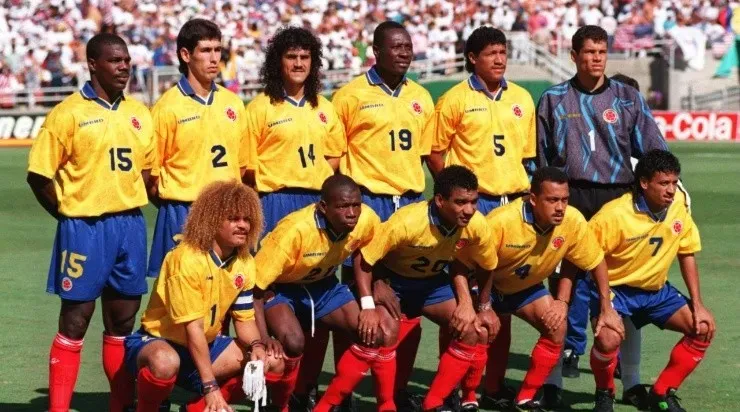
THE NATIONAL SOCCER TEAM OF COLOMBIA LINE UP PRIOR TO THEIR 1994 WORLD CUP MATCH AGAINST THE USA AT THE ROSE BOWL IN PASADENA, CALIFORNIA. Mandatory Credit: Shaun Botterill/ALLSPORT
The 1994 World Cup had begun to exceed even FIFA’s expectations, pre-sale of tickets went fast, the USMNT as early as six months before the tournament was fully aware they would be playing World Cup matches in front of 90,000 fans in some cases.
Group A was anything but an easy draw for the hosts, Colombia was a pre-tournament favorite, especially after their 5-0 defeat of Argentina in Buenos Aires in qualifying, Romania had Florin Răducioiu, Gheorghe Hagi, and Dan Petrescu in their squad, and the team’s first match against Switzerland, they would have to deal with the magic of midfielder Alain Sutter.
The thought that the USMNT could go 0-3 was very real and sent a worry through US Soccer. More so after the players themselves stressed how ridiculous they would look playing in their Adidas 1994 World Cup kits whichlooked better suited for a rock concert than a World Cup match. Nonetheless the Americans had nothing to lose and the world to gain.
The 1994 World Cup for the USMNT

ERIC WYNALDA, LEFT, OF THE USA AND LEONEL ALVAREZ OF COLOMBIA IN ACTION DURING THE USA V COLOMBIA WORLD CUP 1994 MATCH AT THE ROSE BOWL IN LOS ANGELES, CALIFORNIA. Mandatory Credit: Shaun Botterill/ALLSPORT
On June 18th the USMNT took the field against Switzerland, a nervy US side gave up a free kick goal in the 39th minute, it was business as usual, while the US stayed compact, they seemed overwhelmed by Switzerland. At the end of the first half the fortunes and spirit of the US team changed completely when Eric Wynalda scored a world class goal off a free kick in the 44th minute sending the 73,000 fans in the old Pontiac Silverdome into a frenzy. In the second half a more composed US team began to take control but ran out of time and the match ended 1-1 and gave the team a real chance to get to the next round.
On June 22, the USMNT entered their difficult match against Colombia with the support of 94,000 fans at the Rose Bowl. Colombia had been completely manhandled by Romania in their opening match 3-1, the Colombian team had received death threats if they were eliminated in the first round. Knowing that, Bora sent his US team out to play compact but to make use of the Colombians nerves on the counter.
After a few early hiccups the US began to compose themselves and after having good chances to score with Eric Wynalda hitting the post, John Harkes hit a bad cross that Colombian defender Andres Escobar could not control, and the ball entered the net. The US was up 1-0 at the half and would shock the world when Earnie Stewart would put the USMNT 2-0 up in the 52nd minute.

TAB RAMOS OF THE USA, RIGHT, AND ALAIN SUTTER OF SWITZERLAND IN ACTION DURING THE USA V SWITZERLAND MATCH IN DETROIT, MICHIGAN. USA AND SWITZERLAND TIED 1-1. Mandatory Credit: Ben Radford/ALLSPORT
2-0 up and with Colombia shocked and with little answer, the US pushed Colombia back into their own goal with chances by Tab Ramos, Alexi Lalas, and an amazing bicycle kick by Marcelo Balboa that was the most replayed miss of the tournament. Lalas and Balboa played an excellent defensive match, with Meola being solid at every Colombian strike. Despite giving up a late goal the 2-1 victory against Colombia gave the team, program, World Cup, and casual fans a huge boost.
The team celebrated with the fans as if they won the tournament, but the win meant that the US had recorded their first World Cup win since their 1-0 defeat of England in 1950. Overnight Tony Meola, Alexi Lalas, Marcelo Balboa, John Harkes, Eric Wynalda, and Cobi Jones became huge names, and their faces were everywhere on American television.
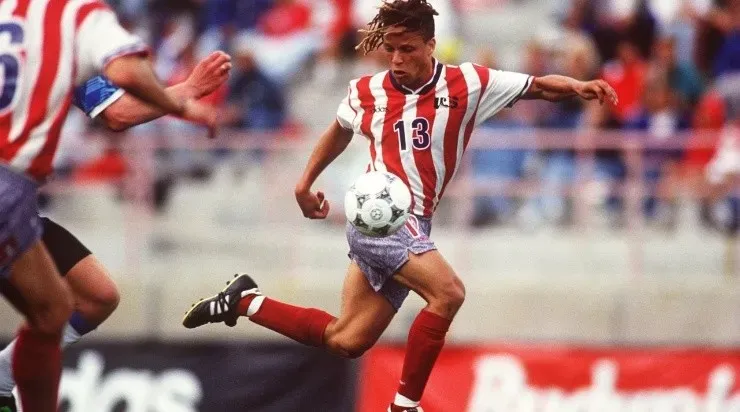
COBI JONES OF THE USA SOCCER TEAM CONTROLS THE BALL ON THE RUN IN USA”S 4-0 VICTORY IN AN INTERNATIONAL FRIENDLY MATCH. Mandatory Credit: Stephen Dunn/ALLSPORT
The third match was a game where the US had already made the round of 16, the win against Colombia gave the team a huge confidence boost, and the US actually attacked Romania with a never say die attitude. A Tony Meola mishap gave Romania a 1-0 lead on a Dan Petrescu goal. That goal stood up despite the US coming close to tying the match. The USMNT finished third a respectable 3 goals for and 3 against and a date on July 4th against Brazil in the round of 16.
In front of a record television audience and 84,000 fans at Stanford Stadium the USMNT faced Brazil against overwhelming odds. The team held tight and frustrated the Brazilians. Early in the match the Americans came close to opening the score, but Brazil would eventually take over the game but could not find the net.
A brutal blow by Leonardo on Tab Ramos took the United States most talented player out of the match with a fractured skull, and in the 72nd minute Bebeto finally broke through and scored the game winning goal. Out of the tournament and in tears the road had ended for the US team who were applauded by the fans in attendance at the stadium.
The World Cup would go on as Italy’s Roberto Baggio would miss a penalty kick that gave Brazil their fourth World Cup title, soccer for 1 month had captured the attention of the United States, and the USMNT’s round of 16 performance had made stars out ofmany onthe team.
Post 1994
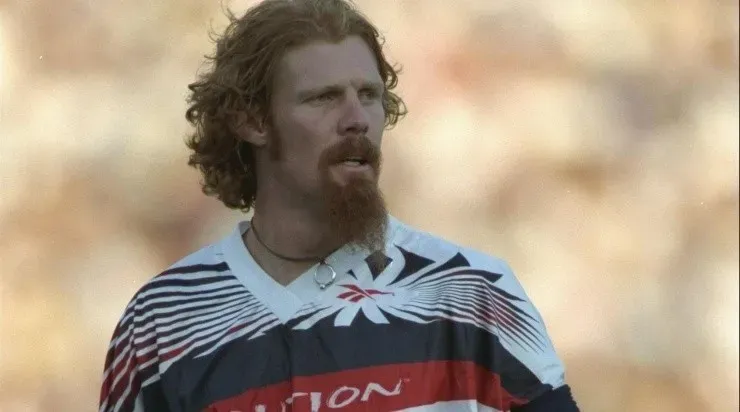
Alexi Lalas of the New England Revolution looks on during a game against the Los Angeles Galaxy at the Rose Bowl in Pasadena, California. The Galaxy won the game, 1-0. Mandatory Credit: Jed Jacobsohn /Allsport
On an individual front the 1994 World Cup helped land professional contracts to many on the squad, Alexi Lalas would move to Serie A becoming the first American to play in Italy. Cobi Jones went to England, Mike Sorber and Marcelo Balboa to Mexico. Claudio Reyna would move to Germany along with other Americans like Joe Max Moore, Mike Lapper and Paul Caligiuri.
MLS was set to kick off in 1995 but would eventually play its first match in 1996 with Tab Ramos being the first player signed by the league. Alexi Lalas, Wynalda, Meola, Balboa, and Jones all returned to kick off the league with other 94 faces such as Roberto Donadoni, Jorge Campos, Hugo Sanchez, Carlos Valderrama, Leonel Álvarez, Marco Etcheverry, and Jaime Moreno.
In 1995 the USMNT, now coached by Steve Sampson, would prove the 1994 World Cup was no fluke and in the Copa America posted 4th place with huge wins over Chile, Argentina (3-0), and Mexico. Hot off of the World Cup and with a semifinal showing at the Copa America it laid the groundwork for MLS to kick off with major momentum and place the USMNT as a serious up and coming nation.
Legacy of 1994
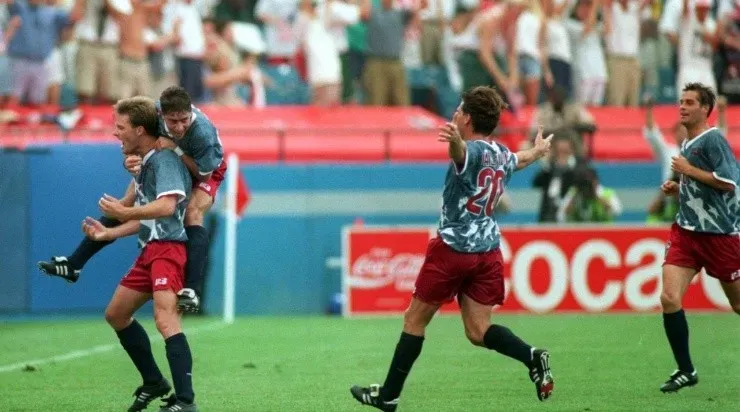
ERIC WYNLANDA IS HUGGED BY TAB RAMOS AFTER SCORING A GOAL ON A PENALTY KICK AGAINST SWITZERLAND AT THE SILVERDOME IN PONTIAC, MICHIGAN. AT RIGHT, USA TEAM MEMBERS PAUL CALIGIURI AND JOHN HARKES RUN TO JOIN THE CELEBRATION. THE GAME END
Without the 1994 World Cup, frankly, there would be no professional soccer in the United States, and while Anti- MLS Twitter will argue that professional soccer would have happened no matter what, the league would not be nearly as strong or noticed. The sport would not have the television exposure it has today, and American soccer players would not have a place to play in MLS.
While it was only 4 games, the 1994 USMNT played 4 of the most important games in the country’s history. It showed the US could compete and WIN at the biggest stage. The 1994 World Cup is dear to the hearts of many fans around the world, in Argentina it’s easier for sports journalist to name the 94 backline of the USMNT than it is to name 5 players from the 2014 squad.
28 years later, even those 1994 USMNT World Cup kits look way better.





